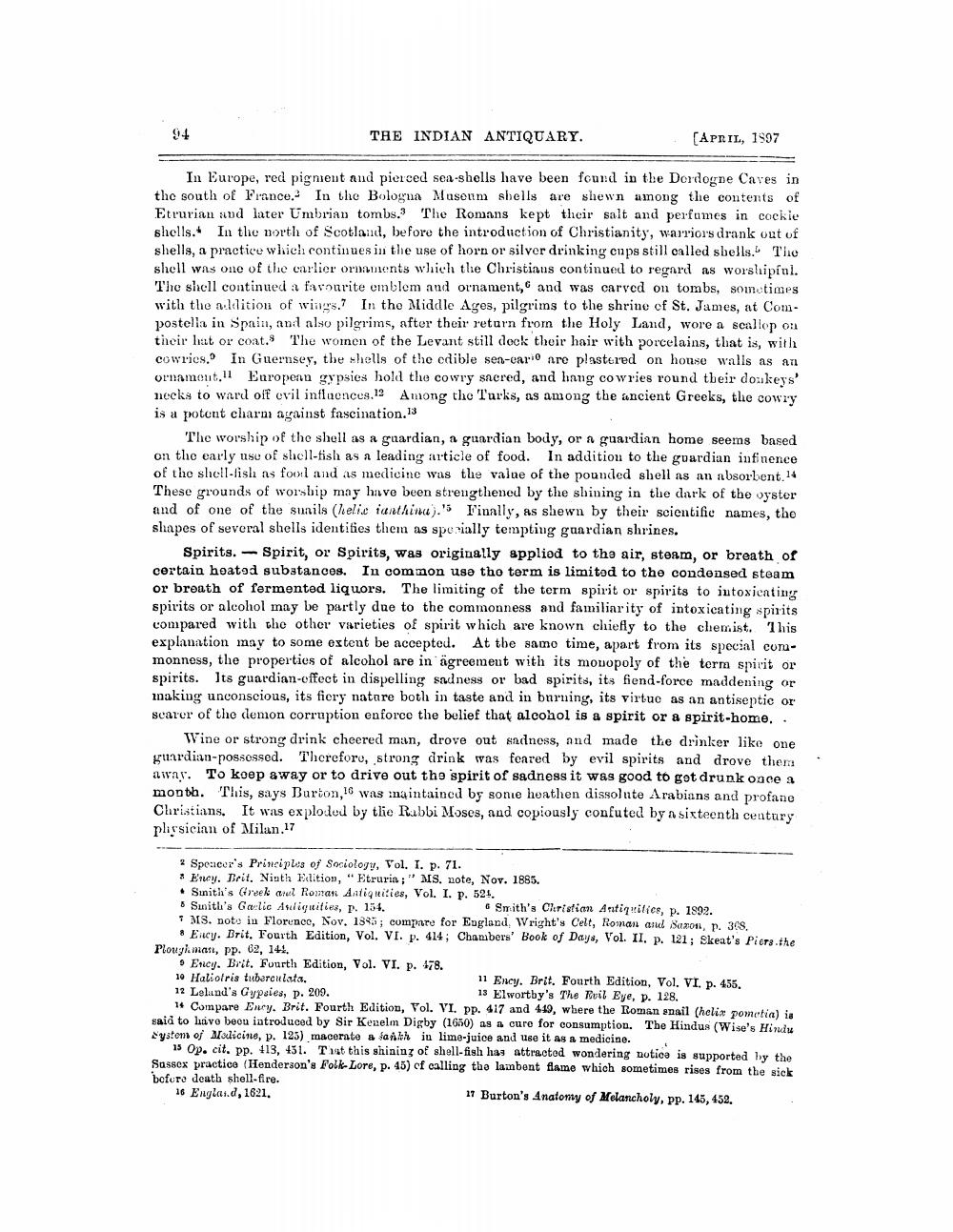________________
94
THE INDIAN ANTIQUARY.
[APRIL, 1997
In Europe, red pigment and pierced sea-shells have been found in the Dordogne Caves in the south of France. In the Bologna Museum shells are shewn among the contents of Etrurian and later Umbrian tombs. The Romans kept their salt and perfumes in cockie shells. In the north of Scotland, before the introduction of Christianity, warriors drank out of shells, a practice which continues in the use of horn or silver drinking cups still called sbells. The shell was one of the earlier ornaments which the Christians continued to regard as worslipínl. The shell continued a favourite emblem and ornament, and was carved on tombs, sometimes with the allition of wings. In the Middle Ages, pilgrims to the shrine of St. James, at Compostella in Spain, and also pilgrims, after their return from the Holy Land, wore a scallop ou their lat or coat. The women of the Levant still dock their hair with porcelains, that is, with cowries. In Guernsey, the shells of the cdible sen-car o are plastered on house walls as an Ornament. European gypsies hold the cowry sacred, and hang cowries round their donkeys' necks to ward off evil influences.12 Among the Turks, as among the ancient Greeks, the coway is a potent charm against fascination. 13
The worship of the shell as a guardian, a guardian body, or a guardian home seems based on the early use of shell-tish as a leading article of food. In addition to the guardian infinence of the shell-lisla as fool and as medicine was the value of the pounded shell as an absorbent. 14 These grounds of worsbip may have been strengthened by the shining in the dark of the oyster and of one of the sunils (helie ianthin).' l'inally, as shewn by their scientific names, the shapes of several shells identifies them as sperially tempting guardian shrines.
Spirits. Spirit, or Spirits, was originally appliod to the air, steam, or breath of certain heated substances. In common use tho term is limited to the condensed steam or breath of fermented liquors. The limiting of the term spirit or spirits to intoxienting spirits or alcohol may be partly due to the commonness and familiarity of intoxicating spirits compared with the other varieties of spirit which are known chiefly to the chemist. This explanation may to some extent be accepted. At the same time, apart from its special corumonness, the properties of alcohol are in agreement with its monopoly of the term spirit or spirits. Its guardian-offect in dispelling sadness or bad spirits, its fiend-force maddening or inaking unconscious, its fiery natare both in taste and in burning, its virtue as an antiseptic or scarer of the demon corruption enforce the belief that alcohol is a spirit or a spirit-home..
Wine or strong drink cheered man, drove out sadness, and made the drinker like one guardian-possossed. Thereforo, strong drink was feared by evil spirits and drove them away. To keep away or to drive out the spirit of sadness it was good to get drunk oace a month. This, says Burton, was inaintained by sonte heathen dissolute Arabians and profane Christians. It was exploded by the Rabbi Moses, and copiously confuted by a sixteenth century plıysician of Milan.17
? Spencer's Principles of Sociology, Vol. I. p. 71. * Ency. Drit. Ninth Exlition, "Etruria ; " MS, note, Nov. 1885. • Sunith's Greek Gul Romari Antiquities, Vol. I. p. 524. Sunith's Garlic Asiguities, P. 154.
Smith's Christian Antiquities, p. 1992. * MS. note in Florence, Nov. 1345; compare for England Wright's Celt, Roman anul Baron, p. 38.
* Excy. Brit. Fourth Edition, Vol. VI. p. 414; Chambers' Book of Days, Vol. II. p. 121; Skeat's Piers.the Plongi mast, pp. 62, 144.
Ency. Brit. Fourth Edition, Vol. VI. p. 478. 10 Haliofris tuberculata.
11 Eney. Brit. Fourth Edition, Vol. VI. p. 455. 12 Leland's Gypsies, p. 209.
13 Elworthy's The Ruil Eye, P. 128. 14 Compare Eary. Brit. Fourth Edition, Vol. VI. PP. 417 and 419, where the Roman snail (helix pomatia) ia said to have been introduced by Sir Kenelm Digby (1650) as a cure for consumption. The Hindus (Wise's Hindu ystem of Modlicine, p. 125) macerato ankle in lime-juice and use it as a medicine.
15 Op. cit. pp. 413, 451. That this shining of shell-fish has attracted wondering notice is supported by the Sassox practica (Henderson's Folk-Lore, p. 45) of calling the lambent flamo which sometimes rises from the sick bofora death shell-fire. 16 England, 1621.
17 Burton's Anatonwy of Melancholy, pp. 145, 452,




